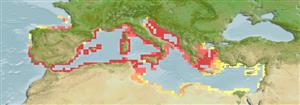>
Blenniiformes (Blennies) >
Blenniidae (Combtooth blennies) > Salariinae
Etymology: Parablennius: Greek, para = the side of + Greek, blennios = mucus (Ref. 45335).
Environment: milieu / climate zone / depth range / distribution range
Ecologie
marien demersaal; diepte 0 - 42 m (Ref. 5981). Subtropical; 46°N - 30°N, 11°W - 36°E
Northeast Atlantic: off Portugal. Also known from the northern Mediterranean.
Grootte / Gewicht / Leeftijd
Maturity: Lm ? range ? - ? cm
Max length : 8.0 cm TL mannelijk / geslacht onbekend; (Ref. 5981)
Facultative air-breathing in the genus (Ref. 126274); Adults occur in the shallow littoral zone to the zone beyond the influence of water movements, over light rocks or pebbles without algal cover and on secondary hard bottoms of coralligenous origin. They feed on periphyton, harpacticoids and algae. Males inhabit narrow piddock holes; they court by nodding, jumping out of hole and back again and swimming in a vertical position. Rivals are threatened by yawning, lateral display and circling, and are attacked by ramming and biting. Reproduction takes place from May to July. Attracted females spawn in resident hole of a males which guards eggs from several families (Ref. 5981). Oviparous. Eggs are demersal and adhesive (Ref. 205), and are attached to the substrate via a filamentous, adhesive pad or pedestal (Ref. 94114). Larvae are planktonic, often found in shallow, coastal waters (Ref. 94114).
Levenscyclus en paargedrag
Maturities | Voortplanting | Spawnings | Egg(s) | Fecundities | Larven
Oviparous, distinct pairing (Ref. 205).
Zander, C.D., 1986. Blenniidae. p. 1096-1112. In P.J.P. Whitehead, M.-L. Bauchot, J.-C. Hureau, J. Nielsen and E. Tortonese (eds.) Fishes of the North-eastern Atlantic and the Mediterranean, volume 3. UNESCO, Paris. (Ref. 5981)
Status op de Rode Lijst van het IUCN (Ref. 130435)
Gevaar voor de mens
Harmless
Gebruik door de mens
Tools
Speciale rapporten
Download XML
Internetbronnen
Estimates based on models
Preferred temperature (Ref.
123201): 16.5 - 19.5, mean 18.1 °C (based on 54 cells).
Fylogenetische diversiteitsindex (Ref.
82804): PD
50 = 0.5000 [Uniqueness, from 0.5 = low to 2.0 = high].
Bayesian length-weight: a=0.00741 (0.00335 - 0.01640), b=3.02 (2.83 - 3.21), in cm total length, based on LWR estimates for this (Sub)family-body shape (Ref.
93245).
Trofisch niveau (Ref.
69278): 3.0 ±0.0 se; based on diet studies.
Weerstandsvermogen (Ref.
120179): Hoog, minimale populatieverdubbelingstijd minder dan 15 maanden (Preliminary K or Fecundity.).
Fishing Vulnerability (Ref.
59153): Low vulnerability (10 of 100).
Nutrients (Ref.
124155): Calcium = 295 [156, 644] mg/100g; Iron = 1.6 [1.0, 3.0] mg/100g; Protein = 18.1 [17.1, 19.1] %; Omega3 = 0.263 [0.141, 0.481] g/100g; Selenium = 20 [9, 43] μg/100g; VitaminA = 22.1 [6.4, 74.0] μg/100g; Zinc = 1.51 [0.99, 2.22] mg/100g (wet weight);
